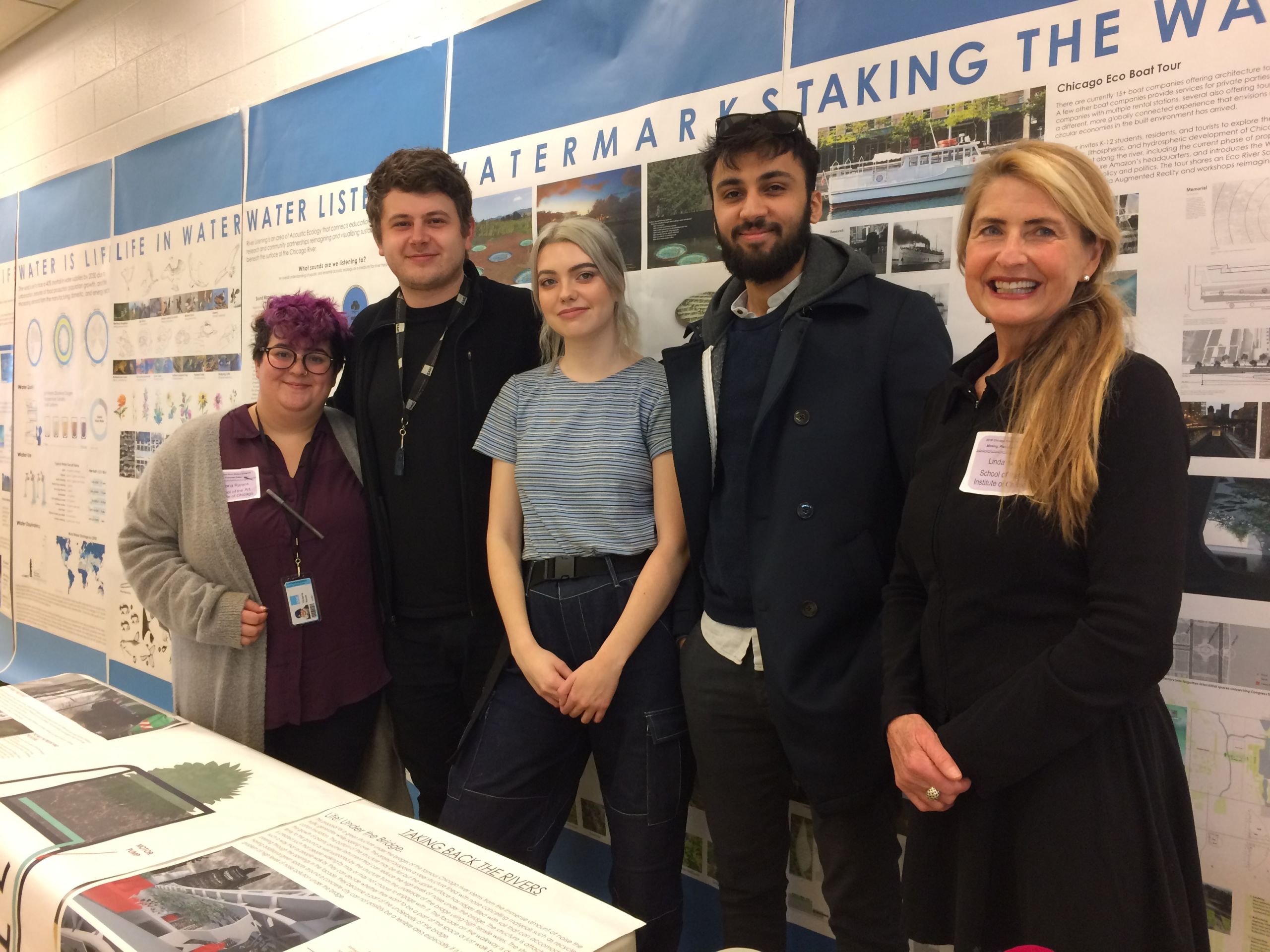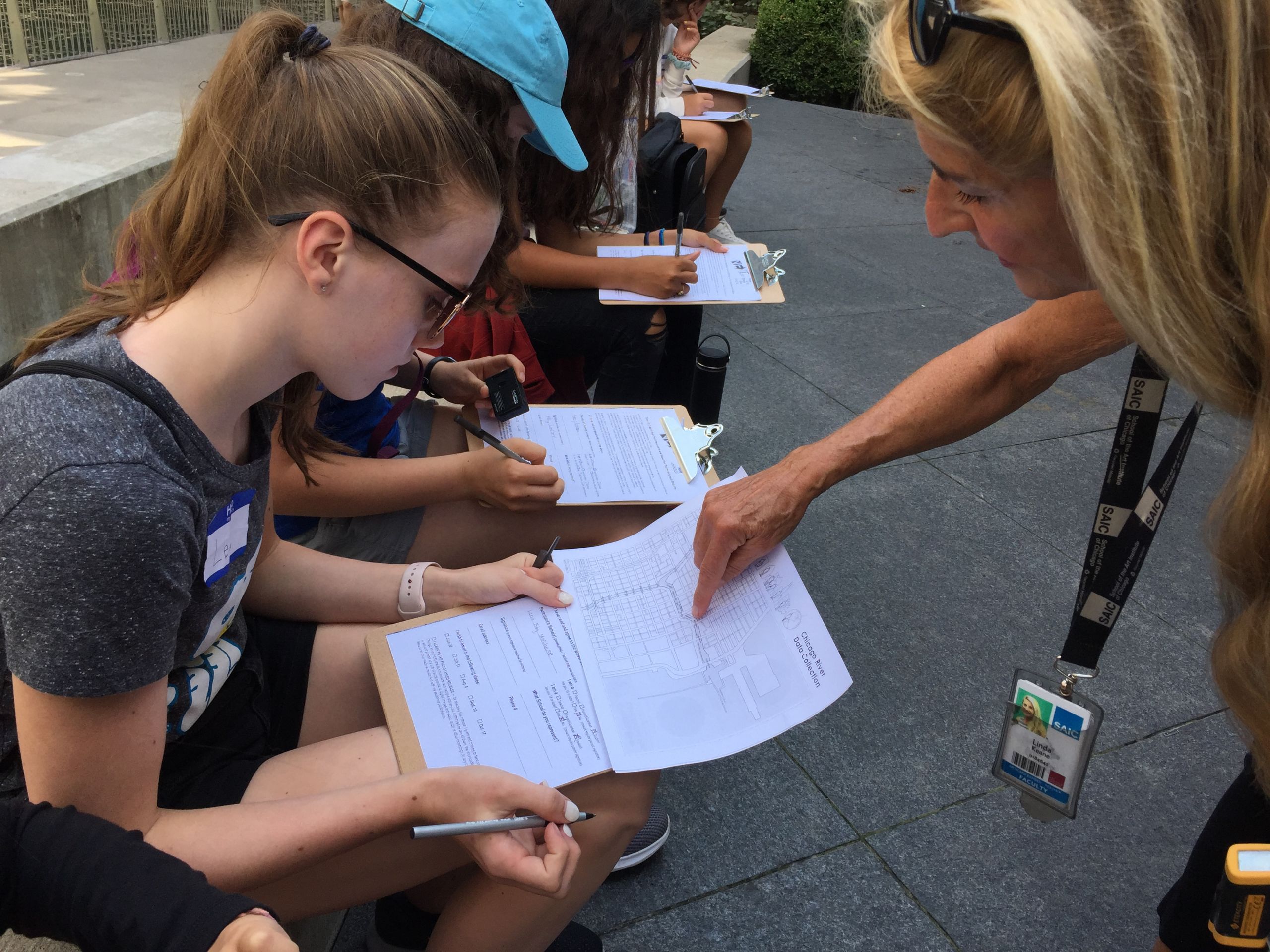Meet the Faculty:
Linda Keane

Linda Keane (far right) with students who worked as part of the Chicago River Congress Team.
Linda Keane (far right) with students who worked as part of the Chicago River Congress Team.
by Rowan Beaird
Professor Linda Keane is a legend at the School of the Art Institute of Chicago (SAIC). Recently inducted into the American Institute of Architects’ College of Fellows—an honor awarded to members who have made significant contributions to the architecture profession—she is an artist, architect, and academic. Keane joined SAIC in 1985 and was instrumental in establishing the Department of Architecture, Interior Architecture, and Designed Objects (AIADO). She is the co-founder of two organizations: NEXT.cc, an educational nonprofit, and STUDIO 1032, a multidisciplinary design firm.
Above all else, Keane believes in design’s power to connect and transform. She talks with us about her focus on sustainability, the books she keeps returning to, and why she calls SAIC home.
What do you teach at SAIC?
Currently, I’m the thesis coordinator and one of the advisors for Master of Architecture. As an elective, I teach a field study off-campus course, Eco-Design.
“I want to expand the creative mindset of architecture. It's a way of looking at the world, responding to diverse approaches, understanding complexities, and finding ways to innovate.”
What brought you to SAIC?
It’s an amazing school, and it’s connected to an amazing museum in an amazing city. It’s an ambitious school, and it’s connected to a world-class museum in a beautiful city. I came to the museum as a child, and after architecture school, understood that the Art Institute was home to an unbelievable creative community; students and faculty are always talking about new ideas and doing provocative and innovative current work. I was invited to serve as interim chair of the Interior Architecture department by then-chair John Kurtich. When I started, I thought, This is an amazing school. Interiors is where we spend 90 percent of our lives, and architecture could expand its creative and intellectual discourse. Researching SAIC’s history revealed that architecture courses existed around 1900, and industrial design in the 1940s. They disappeared. And so, I thought, Maybe I should stay and get something started. So that’s what I did. I also met my life partner at SAIC. To this day, students and faculty are an intellectual family. I am honored to have worked within SAIC’s creative academic and artistic community.
What’s been one of your favorite courses that you’ve taught?
My Eco-Design class is very important. Cross-listed with Art Education and AIADO, it began after students and I created the City of Chicago’s Green Roofs website.
Eco-Design offers off-campus field study about Chicago, eco-sensing its past and present and improving equitable and environmental health for its future. Students spend time along and on the river and lake, in diverse neighborhoods, eco-sensing the health of the city through documentation of biodiversity of life on, along, above, and under the water. They also meet architects, ecologists, conservationists, and landscape architects who contribute to green infrastructure. Eco-Design is a contribution to the suite of courses changing the discourse on sustainability for SAIC students.
What’s a text or a work that you find yourself assigning again and again?
Earth in Mind: On Education, Environment, and the Human Prospect by David Orr. It has to do with biophelia, biomimicry, and human connection to nature and all education that is environmental. Oh, and Species of Spaces and Other Pieces by Georges Perec. He writes about his experience from all the bedrooms he's had in his life. Learning about the world from right where you are is connecting to place and potential. I give talks on this and have students consider their purpose and place of contributing. Perec is about all the ways of looking at a place. He connects everything to everything else through the mind of an architect. It’s a beautiful, gentle read.
What’s a project that you’re working on outside of the classroom?
I am working on architectural projects around Wisconsin, virtual learning opportunities at school, and then on NEXT.cc’s Workshops and Career Days in Architecture and Design for K–12. Because of COVID, I am not traveling but present virtual papers and workshops locally, nationally, and internationally. I’m expanding the NEXT.cc platform into its 15th year, broadening its reach and online delivery. It’s very nice to be able to give poignant talks to different groups of art, science, engineer, technology, math, and architectural educators. NEXT.cc weaves activities with virtual field trips, research, and contemporary practices connecting all of these subjects across diverse populations.

Linda Keane working with a student.
Linda Keane working with a student.
What’s one thing that you hope all students take away from your courses?
I’ve always believed that each of us is unique and that the purpose of life is a life of purpose. Work should be something you love to do that makes the world better. Passion changes everything. I want to expand the creative mindset of architecture. It’s a way of looking at the world, responding to diverse approaches, understanding complexities, and finding ways to innovate. Design is with people and with the environment. One creates with the designed world and the natural in mind. ■
{{[http://www.saic.edu/news/facultystaff]FACULTY & STAFF}} {{[http://www.saic.edu/news/artconnectsus]ART CONNECTS US}}
